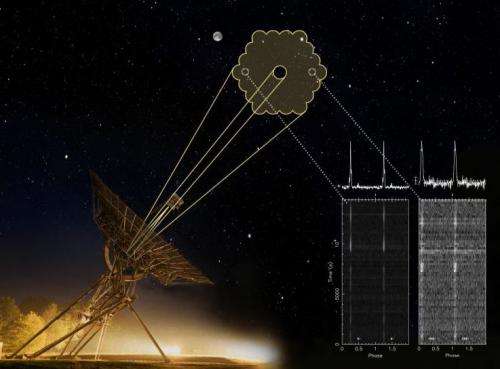New high-speed cameras for Westerbork telescope

(Phys.org) —This week, a team of Dutch astronomers and engineers led by astronomer Joeri van Leeuwen (ASTRON) was awarded a grant to turn the new 'Apertif' receivers on the Westerbork telescope into high-speed cameras. The receivers will expand the Westerbork field of view by over a factor 30 but the system is restricted to making images at the rate of one every second. The new upgrade increases this to 10,000 frames per second, allowing astronomers to survey the sky with greater sensitivity to quick changes. The grant of 540.000 euro by the Netherlands Organisation for Scientific Research (NWO) is part scientific 'NWO-M' investment subsidy, part related to the top sector High Tech Systems and Materials due to the potential for mobile broadband communications. Astronomers will use these new high-speed cameras to detect bright radio flashes from our Milky Way, and beyond.
The Apertif receivers allow astronomers to sensitively scan the sky for radio galaxies that are mostly unchanging. Throughout the Galaxy, however, many short bright radio bursts that last less than one thousandth of a second also go off. Some of these are emitted by radio pulsars, spinning Galactic lighthouses, but others originate from far outside our Galaxy. The nature of these far-off bursts is unclear, but given their distance they must represent enormous explosions comparable to the 'supernovae' that are observed when massive stars explode.
Using the grant, Apertif's vision will be further trained: the receivers' current ability to see as sharp as an eagle will be extended to the quickness of a fly. The algorithms on the current imaging chips will be extended to form 10,000 frames per second. Furthermore, the image processing capacity will be extended with an extra supercomputer, as powerful as the Dutch national supercomputer, to immediately process the data the telescope receives. The phased array feeds and burst-detection processing of Apertif are pathfinder technologies for the Square Kilometre Array (SKA).
In a few years, the high-speed cameras can scan the sky for bright bursts. Thanks to the new processing capabilities these bursts can be recognized immediately, and their properties can be studied with the Westerbork telescope and other telescopes, before they fade. Astronomers aim to thus determine the nature of the explosive bursts.
Provided by Netherlands Institute for Radio Astronomy




















